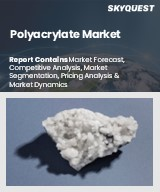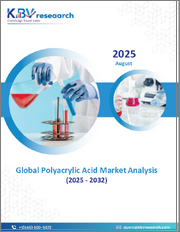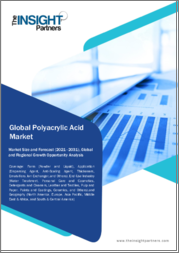
|
시장보고서
상품코드
1728276
세계의 폴리아크릴산(PAA) 시장 : 산업 규모, 점유율, 동향, 기회, 예측 - 판매 채널별, 최종 용도별, 지역별, 경쟁별 부문(2020-2030년)Polyacrylic Acid Market - Global Industry Size, Share, Trends, Opportunity, and Forecast, Segmented By Sales Channel, By End Use, By Region and Competition, 2020-2030F |
||||||
세계의 폴리아크릴산(PAA) 시장은 2024년에 62억 7,710만 달러로 평가되었고, 2030년에는 81억 2,839만 달러에 이를 것으로 예측되며, 예측 기간 중 CAGR 2.96%로 성장할 것으로 예측됩니다.
이 시장은 주로 PAA의 뛰어난 흡수성과 분산 능력에 의한 수처리 솔루션 수요 증가가 견인하고 있습니다. PAA는 폐수 처리에 효과적이기 때문에 이 분야에서 선호되고 있습니다. 게다가 고도의 화장품이나 퍼스널 케어 제품의 소비 고조가, 특히 스킨 케어 및 헤어 케어의 처방에 있어서, 증점제 및 안정제로서 PAA의 사용에 박차를 가하고 있습니다. 세제 업계도 큰 공헌을 하고 있으며, 세정 성능의 향상과 스케일 형성의 방지에 PAA를 활용하고 있습니다. 게다가 PAA가 제품의 내구성과 일관성을 높이는 페인트 및 코팅 분야에서의 수요 증대가 여러 최종 용도 산업에 걸쳐 시장의 성장을 더욱 뒷받침하고 있습니다.
| 시장 개요 | |
|---|---|
| 예측 기간 | 2026-2030년 |
| 시장 규모(2024년) | 62억 7,710만 달러 |
| 시장 규모(2030년) | 81억 2,839만 달러 |
| CAGR(2025-2030년) | 2.96% |
| 급성장 부문 | 직접 |
| 최대 시장 | 아시아태평양 |
시장 성장 촉진요인
퍼스널케어 산업의 성장
주요 시장 과제
원재료 가격 변동
주요 시장 동향
건설 업계의 성장
목차
제1장 개요
제2장 조사 방법
제3장 주요 요약
제4장 COVID-19가 세계의 폴리아크릴산 시장에 미치는 영향
제5장 세계의 폴리아크릴산 시장 전망
- 시장 규모 및 예측
- 금액별
- 시장 점유율 및 예측
- 판매 채널별(직접, 간접)
- 용도별(수처리, 퍼스널케어 및 화장품, 세제 및 세정제, 농업, 섬유 및 코팅, 기타)
- 지역별
- 기업별(2024년)
- 시장 맵
제6장 북미의 폴리아크릴산 시장 전망
- 시장 규모 및 예측
- 시장 점유율 및 예측
- 북미 : 국가별 분석
- 미국
- 멕시코
- 캐나다
제7장 유럽의 폴리아크릴산 시장 전망
- 시장 규모 및 예측
- 시장 점유율 및 예측
- 유럽 : 국가별 분석
- 프랑스
- 독일
- 영국
- 이탈리아
- 스페인
제8장 아시아태평양의 폴리아크릴산 시장 전망
- 시장 규모 및 예측
- 시장 점유율 및 예측
- 아시아태평양 : 국가별 분석
- 중국
- 인도
- 한국
- 일본
- 호주
제9장 남미의 폴리아크릴산 시장 전망
- 시장 규모 및 예측
- 시장 점유율 및 예측
- 남미 : 국가별 분석
- 브라질
- 아르헨티나
- 콜롬비아
제10장 중동 및 아프리카의 폴리아크릴산 시장 전망
- 시장 규모 및 예측
- 시장 점유율 및 예측
- 중동 및 아프리카 : 국가별 분석
- 남아프리카
- 사우디아라비아
- 아랍에미리트(UAE)
제11장 시장 역학
- 성장 촉진요인
- 과제
제12장 시장 동향 및 발전
- 합병 및 인수
- 제품 출시
- 최근 동향
제13장 세계의 폴리아크릴산 시장 : SWOT 분석
제14장 Porter's Five Forces 분석
- 업계 내 경쟁
- 신규 진입의 가능성
- 공급자의 힘
- 고객의 힘
- 대체품의 위협
제15장 경쟁 구도
- BASF SE
- The Dow Chemical Company
- Lubrizol Corporation
- Arkema SA
- NIPPON SHOKUBAI CO., LTD.
- Evonik Industries AG
- Ashland Inc.
- TOAGOSEI CO., LTD.
- SNF Group
- Kao Corporation
제16장 전략적 제안
제17장 기업 소개 및 면책사항
AJY 25.05.27The Global Polyacrylic Acid (PAA) Market was valued at USD 6,277.10 Million in 2024 and is anticipated to reach USD 8,128.39 Million by 2030, growing at a CAGR of 2.96% during the forecast period. The market is primarily driven by increasing demand for water treatment solutions due to PAA's excellent water absorbency and dispersing capabilities. Its effectiveness in treating wastewater makes it a preferred choice in this segment. Additionally, the rising consumption of advanced cosmetic and personal care products is fueling the use of PAA as a thickener and stabilizer, especially in skincare and hair care formulations. The detergent industry is also a significant contributor, utilizing PAA to improve cleaning performance and prevent scale formation. Moreover, growing demand from the paints and coatings sector, where PAA enhances product durability and consistency, is further boosting market growth across multiple end-use industries.
| Market Overview | |
|---|---|
| Forecast Period | 2026-2030 |
| Market Size 2024 | USD 6,277.10 Million |
| Market Size 2030 | USD 8,128.39 Million |
| CAGR 2025-2030 | 2.96% |
| Fastest Growing Segment | Direct |
| Largest Market | Asia Pacific |
Key Market Drivers
Growth in Personal Care Industry
The global personal care and skincare market continues to expand, with projected revenues reaching USD 198.35 billion by 2025. South Korea stands out as a global leader in beauty innovation, influencing product trends worldwide. Polyacrylic Acid is increasingly integral to skincare and haircare formulations due to its role as a stabilizer, thickening agent, and emulsifier. As consumers demand more sophisticated and effective cosmetic solutions-ranging from anti-aging creams to premium hair treatments-the utility of PAA grows. Its ability to improve product consistency, enhance formulation stability, and support premium product performance makes it a critical ingredient. Rising disposable incomes, coupled with growing consumer awareness of product efficacy, are expected to further drive demand for PAA in the personal care sector.
Key Market Challenges
Volatility in Raw Material Prices
A major challenge impacting the Polyacrylic Acid market is the fluctuation in raw material prices, particularly acrylic acid. As the primary feedstock for PAA, acrylic acid's pricing is influenced by supply-demand imbalances, geopolitical uncertainties, and operational disruptions in key production zones. These fluctuations significantly affect production costs, thereby impacting profit margins and pricing strategies for manufacturers. Unpredictable input costs can also lead to downstream pricing challenges in industries such as water treatment, personal care, and paints, where PAA is a key component. In cost-sensitive markets, such volatility may limit consumption or shift demand to alternative solutions, thereby posing a potential threat to sustained market growth.
Key Market Trends
Growth in Construction Industry
The construction sector is increasingly adopting advanced chemical additives to meet the demand for sustainable and high-performance materials. Polyacrylic Acid is finding growing application in this domain, particularly in cement, coatings, and adhesive formulations. As a dispersing agent, PAA enhances the workability and binding efficiency of cement-based products, while also reducing water consumption. Infrastructure development, which contributes 79% of total global GHG emissions, is under pressure to adopt more eco-efficient solutions. Investments aimed at climate resilience and infrastructure sustainability-accounting for 88% of adaptation spending-are further stimulating the demand for performance-enhancing additives like PAA. This trend is expected to sustain growth in PAA demand within the construction sector.
Key Market Players
- BASF SE
- The Dow Chemical Company
- Lubrizol Corporation
- Arkema SA
- NIPPON SHOKUBAI CO., LTD.
- Evonik Industries AG
- Ashland Inc.
- TOAGOSEI CO., LTD.
- SNF Group
- Kao Corporation
Report Scope
In this report, the Global Polyacrylic Acid Market has been segmented into the following categories, in addition to the industry trends which have also been detailed below:
Polyacrylic Acid Market, By Sales Channel:
- Direct
- Indirect
Polyacrylic Acid Market, By End Use:
- Water Treatment
- Personal Care & Cosmetic
- Detergents & Cleanings
- Agriculture
- Textile & Coatings
- Others
Polyacrylic Acid Market, By Region:
- North America
- United States
- Canada
- Mexico
- Europe
- France
- United Kingdom
- Italy
- Germany
- Spain
- Asia Pacific
- China
- India
- Japan
- Australia
- South Korea
- South America
- Brazil
- Argentina
- Colombia
- Middle East & Africa
- South Africa
- Saudi Arabia
- UAE
Competitive Landscape
Company Profiles: Detailed analysis of the major companies present in the Global Polyacrylic Acid Market.
Available Customizations
Global Polyacrylic Acid Market report with the given market data, TechSci Research offers customizations according to a company's specific needs. The following customization options are available for the report:
Company Information
- Detailed analysis and profiling of additional market players (up to five).
Table of Contents
1. Product Overview
- 1.1. Market Definition
- 1.2. Scope of the Market
- 1.2.1. Markets Covered
- 1.2.2. Years Considered for Study
- 1.2.3. Key Market Segmentations
2. Research Methodology
- 2.1. Objective of the Study
- 2.2. Baseline Methodology
- 2.3. Key Industry Partners
- 2.4. Major Association and Secondary Sources
- 2.5. Forecasting Methodology
- 2.6. Data Triangulation & Validation
- 2.7. Assumptions and Limitations
3. Executive Summary
- 3.1. Overview of the Market
- 3.2. Overview of Key Market Segmentations
- 3.3. Overview of Key Market Players
- 3.4. Overview of Key Regions/Countries
- 3.5. Overview of Market Drivers, Challenges, and Trends
4. Impact of COVID-19 on Global Polyacrylic Acid Market
5. Global Polyacrylic Acid Market Outlook
- 5.1. Market Size & Forecast
- 5.1.1. By Value
- 5.2. Market Share & Forecast
- 5.2.1. By Sales Channel (Direct, Indirect)
- 5.2.2. By End Use (Water Treatment, Personal Care & Cosmetic, Detergents & Cleanings, Agriculture, Textile & Coatings, Others)
- 5.2.3. By Region
- 5.2.4. By Company (2024)
- 5.3. Market Map
6. North America Polyacrylic Acid Market Outlook
- 6.1. Market Size & Forecast
- 6.1.1. By Value
- 6.2. Market Share & Forecast
- 6.2.1. By Sales Channel
- 6.2.2. By End Use
- 6.2.3. By Country
- 6.3. North America: Country Analysis
- 6.3.1. United States Polyacrylic Acid Market Outlook
- 6.3.1.1. Market Size & Forecast
- 6.3.1.1.1. By Value
- 6.3.1.2. Market Share & Forecast
- 6.3.1.2.1. By Sales Channel
- 6.3.1.2.2. By End Use
- 6.3.1.1. Market Size & Forecast
- 6.3.2. Mexico Polyacrylic Acid Market Outlook
- 6.3.2.1. Market Size & Forecast
- 6.3.2.1.1. By Value
- 6.3.2.2. Market Share & Forecast
- 6.3.2.2.1. By Sales Channel
- 6.3.2.2.2. By End Use
- 6.3.2.1. Market Size & Forecast
- 6.3.3. Canada Polyacrylic Acid Market Outlook
- 6.3.3.1. Market Size & Forecast
- 6.3.3.1.1. By Value
- 6.3.3.2. Market Share & Forecast
- 6.3.3.2.1. By Sales Channel
- 6.3.3.2.2. By End Use
- 6.3.3.1. Market Size & Forecast
- 6.3.1. United States Polyacrylic Acid Market Outlook
7. Europe Polyacrylic Acid Market Outlook
- 7.1. Market Size & Forecast
- 7.1.1. By Value
- 7.2. Market Share & Forecast
- 7.2.1. By Sales Channel
- 7.2.2. By End Use
- 7.2.3. By Country
- 7.3. Europe: Country Analysis
- 7.3.1. France Polyacrylic Acid Market Outlook
- 7.3.1.1. Market Size & Forecast
- 7.3.1.1.1. By Value
- 7.3.1.2. Market Share & Forecast
- 7.3.1.2.1. By Sales Channel
- 7.3.1.2.2. By End Use
- 7.3.1.1. Market Size & Forecast
- 7.3.2. Germany Polyacrylic Acid Market Outlook
- 7.3.2.1. Market Size & Forecast
- 7.3.2.1.1. By Value
- 7.3.2.2. Market Share & Forecast
- 7.3.2.2.1. By Sales Channel
- 7.3.2.2.2. By End Use
- 7.3.2.1. Market Size & Forecast
- 7.3.3. United Kingdom Polyacrylic Acid Market Outlook
- 7.3.3.1. Market Size & Forecast
- 7.3.3.1.1. By Value
- 7.3.3.2. Market Share & Forecast
- 7.3.3.2.1. By Sales Channel
- 7.3.3.2.2. By End Use
- 7.3.3.1. Market Size & Forecast
- 7.3.4. Italy Polyacrylic Acid Market Outlook
- 7.3.4.1. Market Size & Forecast
- 7.3.4.1.1. By Value
- 7.3.4.2. Market Share & Forecast
- 7.3.4.2.1. By Sales Channel
- 7.3.4.2.2. By End Use
- 7.3.4.1. Market Size & Forecast
- 7.3.5. Spain Polyacrylic Acid Market Outlook
- 7.3.5.1. Market Size & Forecast
- 7.3.5.1.1. By Value
- 7.3.5.2. Market Share & Forecast
- 7.3.5.2.1. By Sales Channel
- 7.3.5.2.2. By End Use
- 7.3.5.1. Market Size & Forecast
- 7.3.1. France Polyacrylic Acid Market Outlook
8. Asia Pacific Polyacrylic Acid Market Outlook
- 8.1. Market Size & Forecast
- 8.1.1. By Value
- 8.2. Market Share & Forecast
- 8.2.1. By Sales Channel
- 8.2.2. By End Use
- 8.2.3. By Country
- 8.3. Asia Pacific: Country Analysis
- 8.3.1. China Polyacrylic Acid Market Outlook
- 8.3.1.1. Market Size & Forecast
- 8.3.1.1.1. By Value
- 8.3.1.2. Market Share & Forecast
- 8.3.1.2.1. By Sales Channel
- 8.3.1.2.2. By End Use
- 8.3.1.1. Market Size & Forecast
- 8.3.2. India Polyacrylic Acid Market Outlook
- 8.3.2.1. Market Size & Forecast
- 8.3.2.1.1. By Value
- 8.3.2.2. Market Share & Forecast
- 8.3.2.2.1. By Sales Channel
- 8.3.2.2.2. By End Use
- 8.3.2.1. Market Size & Forecast
- 8.3.3. South Korea Polyacrylic Acid Market Outlook
- 8.3.3.1. Market Size & Forecast
- 8.3.3.1.1. By Value
- 8.3.3.2. Market Share & Forecast
- 8.3.3.2.1. By Sales Channel
- 8.3.3.2.2. By End Use
- 8.3.3.1. Market Size & Forecast
- 8.3.4. Japan Polyacrylic Acid Market Outlook
- 8.3.4.1. Market Size & Forecast
- 8.3.4.1.1. By Value
- 8.3.4.2. Market Share & Forecast
- 8.3.4.2.1. By Sales Channel
- 8.3.4.2.2. By End Use
- 8.3.4.1. Market Size & Forecast
- 8.3.5. Australia Polyacrylic Acid Market Outlook
- 8.3.5.1. Market Size & Forecast
- 8.3.5.1.1. By Value
- 8.3.5.2. Market Share & Forecast
- 8.3.5.2.1. By Sales Channel
- 8.3.5.2.2. By End Use
- 8.3.5.1. Market Size & Forecast
- 8.3.1. China Polyacrylic Acid Market Outlook
9. South America Polyacrylic Acid Market Outlook
- 9.1. Market Size & Forecast
- 9.1.1. By Value
- 9.2. Market Share & Forecast
- 9.2.1. By Sales Channel
- 9.2.2. By End Use
- 9.2.3. By Country
- 9.3. South America: Country Analysis
- 9.3.1. Brazil Polyacrylic Acid Market Outlook
- 9.3.1.1. Market Size & Forecast
- 9.3.1.1.1. By Value
- 9.3.1.2. Market Share & Forecast
- 9.3.1.2.1. By Sales Channel
- 9.3.1.2.2. By End Use
- 9.3.1.1. Market Size & Forecast
- 9.3.2. Argentina Polyacrylic Acid Market Outlook
- 9.3.2.1. Market Size & Forecast
- 9.3.2.1.1. By Value
- 9.3.2.2. Market Share & Forecast
- 9.3.2.2.1. By Sales Channel
- 9.3.2.2.2. By End Use
- 9.3.2.1. Market Size & Forecast
- 9.3.3. Colombia Polyacrylic Acid Market Outlook
- 9.3.3.1. Market Size & Forecast
- 9.3.3.1.1. By Value
- 9.3.3.2. Market Share & Forecast
- 9.3.3.2.1. By Sales Channel
- 9.3.3.2.2. By End Use
- 9.3.3.1. Market Size & Forecast
- 9.3.1. Brazil Polyacrylic Acid Market Outlook
10. Middle East and Africa Polyacrylic Acid Market Outlook
- 10.1. Market Size & Forecast
- 10.1.1. By Value
- 10.2. Market Share & Forecast
- 10.2.1. By Sales Channel
- 10.2.2. By End Use
- 10.2.3. By Country
- 10.3. MEA: Country Analysis
- 10.3.1. South Africa Polyacrylic Acid Market Outlook
- 10.3.1.1. Market Size & Forecast
- 10.3.1.1.1. By Value
- 10.3.1.2. Market Share & Forecast
- 10.3.1.2.1. By Sales Channel
- 10.3.1.2.2. By End Use
- 10.3.1.1. Market Size & Forecast
- 10.3.2. Saudi Arabia Polyacrylic Acid Market Outlook
- 10.3.2.1. Market Size & Forecast
- 10.3.2.1.1. By Value
- 10.3.2.2. Market Share & Forecast
- 10.3.2.2.1. By Sales Channel
- 10.3.2.2.2. By End Use
- 10.3.2.1. Market Size & Forecast
- 10.3.3. UAE Polyacrylic Acid Market Outlook
- 10.3.3.1. Market Size & Forecast
- 10.3.3.1.1. By Value
- 10.3.3.2. Market Share & Forecast
- 10.3.3.2.1. By Sales Channel
- 10.3.3.2.2. By End Use
- 10.3.3.1. Market Size & Forecast
- 10.3.1. South Africa Polyacrylic Acid Market Outlook
11. Market Dynamics
- 11.1. Drivers
- 11.2. Challenges
12. Market Trends & Developments
- 12.1. Merger & Acquisition (If Any)
- 12.2. Product Launches (If Any)
- 12.3. Recent Developments
13. Global Polyacrylic Acid Market: SWOT Analysis
14. Porters Five Forces Analysis
- 14.1. Competition in the Industry
- 14.2. Potential of New Entrants
- 14.3. Power of Suppliers
- 14.4. Power of Customers
- 14.5. Threat of Substitute Products
15. Competitive Landscape
- 15.1. BASF SE
- 15.1.1. Business Overview
- 15.1.2. Company Snapshot
- 15.1.3. Products & Services
- 15.1.4. Financials (As Reported)
- 15.1.5. Recent Developments
- 15.1.6. Key Personnel Details
- 15.1.7. SWOT Analysis
- 15.2. The Dow Chemical Company
- 15.3. Lubrizol Corporation
- 15.4. Arkema SA
- 15.5. NIPPON SHOKUBAI CO., LTD.
- 15.6. Evonik Industries AG
- 15.7. Ashland Inc.
- 15.8. TOAGOSEI CO., LTD.
- 15.9. SNF Group
- 15.10. Kao Corporation
16. Strategic Recommendations
17. About Us & Disclaimer
(주말 및 공휴일 제외)














